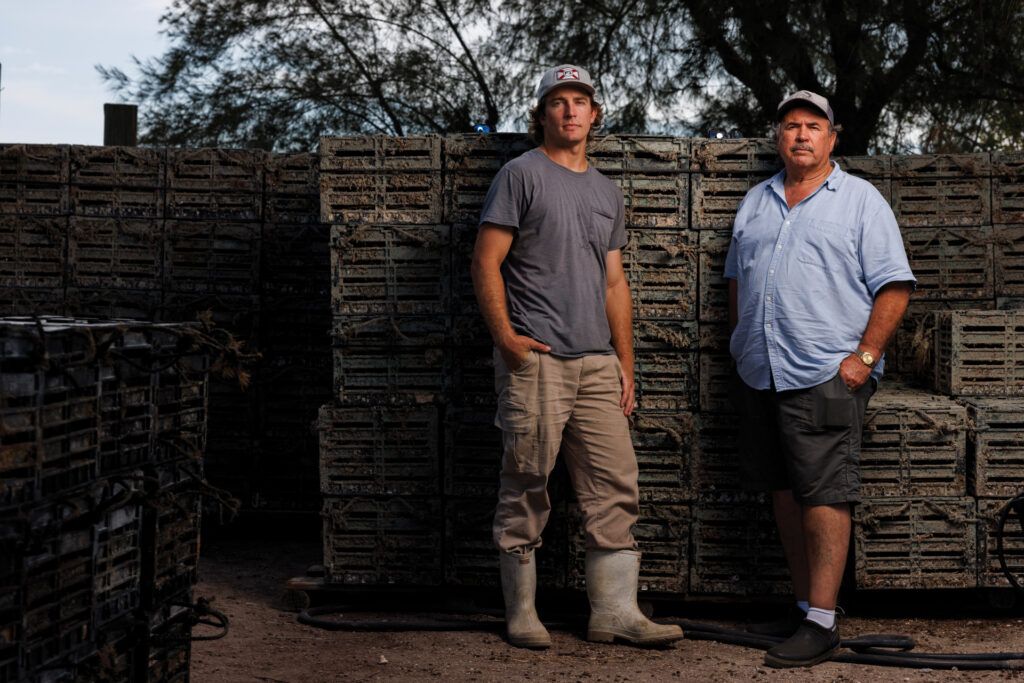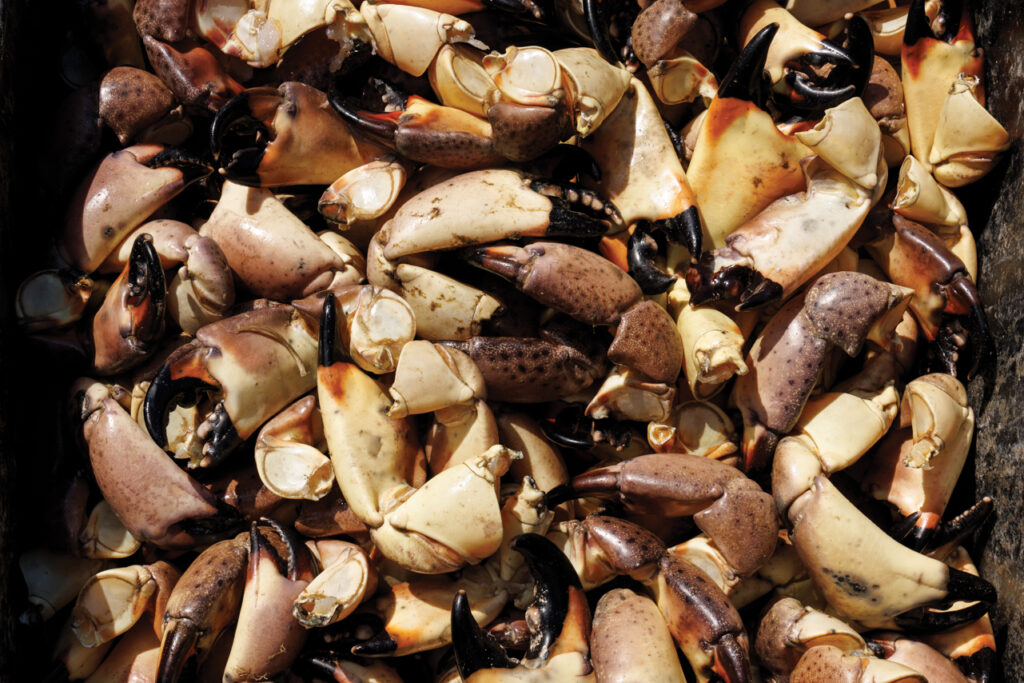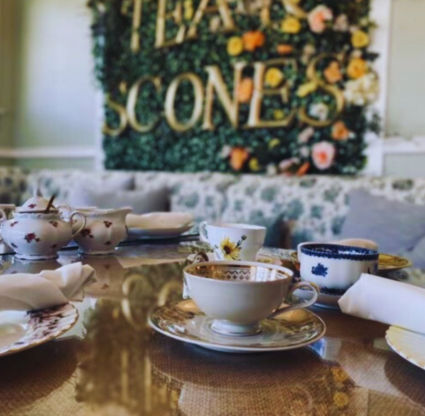Everglades City’s fishing families are resilient by virtue of necessity. The stone crab industry embodies this, dating back to Chokoloskee native and commercial crabber Ernest Hamilton.
In the 1920s, blue crabs were popular across the East Coast—but the harvest around the Everglades became problematic as stone crabs pushed blue crabs out of the traps. Fishers had long discarded the crustacean, as stone crab, cooked alongside the blues, turned to mush—the claws overcooked. Ernest was first to recognize their fragility—and potential. He halved the traditional cooking time, then blanched the claws in an ice bath, yielding delicate, sweet meat. A few years later, Ernest and others discovered they only needed to harvest the claws—the body remains inedible while the pinchers regrow within a year. Everglades City became the self-proclaimed Stone Crab Capital of the World, with crabbers now harvesting more than 300,000 pounds of the delicacy each year. What was once a nuisance became a $30 million-a-year industry.
On a cloudless April morning, I travel to Grimm’s Stone Crab in Everglades City to meet with the seafood market’s owner, Howie Grimm, and his son, Quinton. Howie also happens to be the town’s mayor, and Quinton is Ernest Hamilton’s great-grandson on his mother’s side. Grimm’s overlooks the Barron River, its docks piled high with stone crab traps and buoys, tangled in bits of barnacle and seagrass. Sunlight reflects off the water and into the market, streaming from stainless steel processing tables to large metal fish tubs, baskets and boxes. Trays of stone crab claws nestle into a blanket of ice, like orange sequins across the market’s lone silver display case.
The Grimms believe the generational nature of stone crabbing offsets any instability in the industry’s future, as each insists on preserving it for the next generation of crabbers. The pair discuss this from the middle of their fish house, framed on either side by walk-in coolers teeming with stonies.
Howie Grimm: People have asked before if we would abandon the town. I said, ‘When a tornado goes through a town in Oklahoma, wipes it out, do they move the town? No.’ So if, say, the water does continue to rise, we’ll figure it out. We’ll get around by boat. You know, we’ll do whatever we have to. This town is stronger than it has been in a long time. And I really feel good about where we’re headed with our younger people. And with doing the right thing, like shortening the season.
Stone crab season, which runs October 15 through May 1, was shortened by two weeks beginning in 2020 to prevent overfishing.
Quinton Grimm: At the end of season, the crabs are full of eggs. The less you interfere with them, the better. And that’s any of the younger guys that crab around here—they’re about preserving the industry. They’re in it for the long haul.
Howie: Dad always said: ‘They can make all the laws they want, but unless you do the right thing when nobody’s looking, it’s not gonna work.’
When I ask if the young stone crabbers they refer to are from fishing families, they stop, look at me and say, in unison: “Every one of them.”
Howie: Stone crabbing just takes a certain kind of people. You have to love it. And that’s the truth. And that’s the way commercial fishing has always been. You really don’t do it for the money.
Quinton: If you don’t love it, you won’t make it. It’s so different from normal life that unless you’ve grown up in it and are already used to it—trying to come into something like this, it’s a big adjustment. I tried something else after high school, considered college, but I just—I was missing that part, you know. I grew up on the water. I was lucky enough [that] my grandfather—he had retired 10 years or so before I got into crabbing—he still had his boat, so when I decided that I wanted to stone crab, he got the boat ready for me and showed me how to do it.
Quinton’s grandfather, Billy Raffield, is known throughout Chokoloskee and Everglades City as the ‘King of the Stone Crabbers,’ reportedly harvesting more than any other crabber in his time. His boat, now Quinton’s, is named Miss Trudy, after Quinton’s grandmother. I ask how long he intends to run his grandfather’s boat. A wide smile cracks his stoicism. A fisher’s pride emerges.
Quinton: Until the day I die.
Howie and Quinton’s earliest memories match. Each was 6 or 7 when they first chased stone crabs across the bow of the boat.
Quinton: When I was growing up, my dad and grandfather would crab all day, then fish all night. But in the beginning, when stone crabbing first started, my great grandfather, Ernest, would crab all day, get in, cook the crabs—there was no fish house back then—get it ready to take to Miami, go sell in Miami, come back, then do it all again. I mean, they were constantly working, trying to make something. They were building the industry while they were fishing it.

That continues today. Howie’s other son, Justin, who helps run the seafood market, wheels a tub packed full of claws toward the front counter. A musical sound emerges—stone crab shells clicking and clacking, the murmur of metal. When ready, the claws are shipped to Miami or sold through the Grimms’ retail market. Locals and tourists alike frequent the historic fish house for fresh-off-the-boat stone crab. An Everglades City haul can also be found at various Barron River fixtures, such as the local-favorite Camellia Street Grill or Triad Seafood Market and Cafe, where native sons and daughters go to get their claws for baptisms and anniversary parties.
As our conversation winds down, the sun sweeps across the docks, offering its last bit of afternoon light. Behind Howie and Quinton—the processing tables, the tubs, the baskets and the Barron River—all is silver and gold. I ask Howie and Quinton if stone crab remains the heart of Everglades City.
Howie: Stone crabbing is half the heart of Everglades City, and tourism is the other half. People want to see a real commercial fishing town.
The Grimms help preserve both. A haul of stone crab moves through the town from the dock to the table, one family, then another, bound up in memory and Old Florida dreams, each generation ensuring there’s plenty for the next.
Howie: All that property along the riverfront, from [Ernest] Hamilton Stone Crab down, it all belongs to the city, and there’s a section that we lease only to commercial fishermen. You need a commercial fishing license to even be considered because we want to make sure that those docks stay in fishermen’s names.
Quinton’s great-grandfather opened Ernest Hamilton Stone Crab in the seventies. It’s now owned by Joe’s Stone Crab in Miami.
Quinton: That’s some of my earliest memories out [on the riverfront], sitting around those picnic tables with Grandma and Grandpa eating crabs.
The sweet, firm and succulent stone crab is relished on its own, with a drizzle of lime juice and butter, or alongside mustard sauce. Enjoying stone crab at the source, here in Everglades City, is a rite of passage for many, from fishers to native Floridians—and those who wish to be. I ask if they ever tire of the flavor. Howie shakes his head as if he’s baffled.
Howie: We eat it every day.
Quinton and I grin, acknowledging the question didn’t need asking.
Quinton: Every day.





